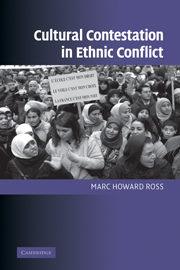Book contents
- Frontmatter
- Contents
- List of figures
- Preface
- 1 Introduction: easy questions and hard answers, what are they fighting about?
- 2 The political psychology of competing narratives
- 3 Narratives and performance: ritual enactment and psychocultural dramas in ethnic conflict
- 4 Loyalist parades in Northern Ireland as recurring psychocultural dramas
- 5 Where is Barcelona? Imagining the nation without a state
- 6 Digging up the past to contest the present: politics and archeology in Jerusalem's Old City
- 7 Dressed to express: Islamic headscarves in French schools
- 8 The politics of memory and memorialization in post-apartheid South Africa
- 9 Enlarging South Africa's symbolic landscape
- 10 Flags, heroes, and statues: inclusive versus exclusive identity markers in the American South
- 11 Culture's central role in ethnic conflict
- References
- Index
- Cambridge Cultural Social Studies
9 - Enlarging South Africa's symbolic landscape
Published online by Cambridge University Press: 22 September 2009
- Frontmatter
- Contents
- List of figures
- Preface
- 1 Introduction: easy questions and hard answers, what are they fighting about?
- 2 The political psychology of competing narratives
- 3 Narratives and performance: ritual enactment and psychocultural dramas in ethnic conflict
- 4 Loyalist parades in Northern Ireland as recurring psychocultural dramas
- 5 Where is Barcelona? Imagining the nation without a state
- 6 Digging up the past to contest the present: politics and archeology in Jerusalem's Old City
- 7 Dressed to express: Islamic headscarves in French schools
- 8 The politics of memory and memorialization in post-apartheid South Africa
- 9 Enlarging South Africa's symbolic landscape
- 10 Flags, heroes, and statues: inclusive versus exclusive identity markers in the American South
- 11 Culture's central role in ethnic conflict
- References
- Index
- Cambridge Cultural Social Studies
Summary
Since 1994 the symbolic landscape in South Africa has been radically altered. As discussed in Chapter 8, transformations of older spaces such as universities, parks, public squares, beaches, and government buildings through appropriation and modification communicate new powerful messages. Any analysis would be incomplete, however, without consideration of new sites and cultural institutions such as monuments, memorials, and museums that recount and legitimate the experiences of the county's previously politically voiceless majority and those who actively struggled to rid the country of apartheid. The new monuments and memorials operate as “gestures of compensation” in an effort to mediate between the past and present and to acknowledge the events and experiences that went unmarked for so long (Marschall 2004).
Official and unofficial new sites throughout the country present a new and different symbolic landscape in a variety of ways. There are, however, certainly themes and images that are common across these new sites. For example, most include visual images and other references to Nelson Mandela, whose picture was banned from the country for almost thirty years, in telling the story of the ultimate triumph over apartheid. Accounts of the story of survival and the inclusive narrative of struggle and resistance are widespread, emphasizing that people from all groups were active in the fight against apartheid and that the previous regime's focus on race and racial differences was an explicit construction. There are some dramatic ways in which this is communicated.
- Type
- Chapter
- Information
- Cultural Contestation in Ethnic Conflict , pp. 251 - 279Publisher: Cambridge University PressPrint publication year: 2007



